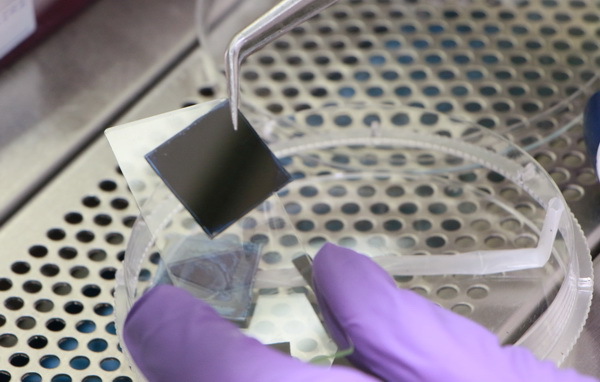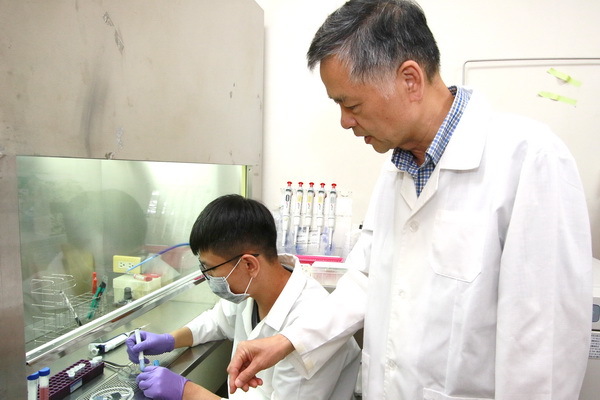Professor Jiunn-Der Liao’s Virus Rapid Screening Test Selected for Ministry of Science Technology’s Epidemic Prevention Technology Development Program
COVID-19 (SARS-CoV-2) has spread across the entire globe, and many countries are actively working to develop rapid screening techniques. Taking a material science and engineering approach, Professor Jiunn-Der Liao from the Department of Materials Science and Engineering at National Cheng Kung University (NCKU) and his team are developing nanoscale trap-based capture technology to catch antigen particles even if there is just one particle present. The test would relieve the need for repetitive nucleic acid or other serologic testing, and be able to detect the presence of the target virus simply by analyzing the chemical composition of the viral envelope. Coupled target virus with hot-spot test cluster has also been developed by Prof. Liao’s team, the viral signals can be further identified to enable detection within a minute. This screening technology was selected to be part of the Ministry of Science and Technology’s (MoST) development project for epidemic prevention technologies, and will be applied towards developing COVID-19 test pieces. The technology is expected to contribute to ongoing efforts in epidemic prevention.

NCKU Professor Jiunn-Der Liao’s Virus Rapid Screening Test
Within then six months, Prof. Liao’s team is aiming to finish building a mapping database for COVID-19 and as well as a prototype for a mobile testing facility that can offer on-site testing support anywhere. The team has already begun planning their collaborative efforts with the NCKU College of Medicine and the NCKU Hospital.
A viral particle is microscopic and is only around 100 nanometers in size. Between 2009 and 2012, Prof. Liao thought of the concept of “fighting (by finding) nano with nano” and applied it in his research to create nanoscale traps to capture viral particles. He developed a test piece with multiple nanoscale funnel-shaped cavities which could trap viral particles. The technique could detect a viral presence even if there is only particle. To identify the virus species or strain, you would need only to analyze the chemical composition of the viral envelope. Moreover, the test could tell whether the virus was live, attenuated, dead, or even mutated. This test piece has experimented for seven types of viruses, including H1N1, SARS and influenza among other types of viruses. The technology was patented in 2012 and 2020, respectively.
The team has also considered the possibility of the viral particle missing its chance to be captured and landing outside of the nanocavity. In 2019, Prof. Liao led his students in developing an entirely new viral hots-pot test cluster that produce the effect of collective amplification. By applying lasers onto the test cluster, the strength and scope of the spectrometer would increase if any particle of the targeted virus is detected on the test cluster. By simultaneously using nanocavity and hot-spot test cluster, detection and confirmation can be achieved within one minute.

Professor Jiunn-Der Liao and his team are developing nanoscale trap-based capture technology to catch antigen particles even if there is just one particle present.
Current virus detection practices utilize multiple nucleic acid testing. The virus’ ribonucleic acid can be read by leveraging nucleic acid sequencing and particle detection technologies. The entire process takes at least four hours, and the costly equipment used cannot be easily transported or moved. Within the next six months, Prof. Liao’s team aims to build a Raman spectroscopy database for mapping COVID-19. The envelope of viral particles caught by nanoscale trap test pieces and hots-pot test cluster will be immediately experimented and compared against data in the database to achieve COVID-19 rapid screening and detection under one minute.
The COVID-19 pandemic has spread all around the world. Prof. Liao has expressed that installing testing facilities at airports and ports or moving mobile testing facilities closer to these areas will enhance surveillance efforts against the virus. Within the next six months, the team endeavors to build the prototype of the mobile emergency testing facility. The team hopes to receive further support in their efforts so that they can translate the fruits of their research and their concept of a mobile facility into reality.
Provider:
News Center
Date:
2020-07-08




